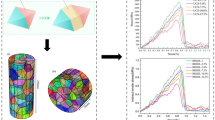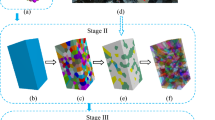Abstract
Based on the physical properties of the laboratory experiments, a grain-based discrete element model (GB-DEM) is developed to simulate the fracture behaviour of ice under confined compressive loading conditions. The microscopic contact parameters are successfully calibrated in the iterative framework to match the macroscopic mechanical properties of the single crystals and polycrystalline ice obtained from laboratory tests. The numerical results are in great agreement with the macroscopic mechanical properties obtained from laboratory tests with errors of less than 6%. Then, the GBM model is used to study the multi-scale fracture behaviours and failure modes of the polycrystalline ice under tension and compression under different confined pressures. The numerical results reveal that only tensile cracks are generated on the grain boundary in the direct tension test. More trans-granular contacts are failed with tension or shear when under compression loading. In addition, tension is the main failure mechanism of specimens under tension or compression loading conditions through the evolution of microscopic cracks. With the increase in confined pressure, the macroscopic cracks formed by microscopic cracks and the high-crack-density area induced by the grain breakage and boundary failure become prominent. At the same time, the number of shear cracks increases obviously.





















Similar content being viewed by others
References
Taylor R, Jordaan I (2015) Probabilistic fracture mechanics analysis of spalling during edge indentation in ice. Eng Fract Mech 134:242–266
Ni B-Y et al (2020) On the development of ice-water-structure interaction. J Hydrodyn 32(4):629–652
Xue Y et al (2020) A review for numerical simulation methods of ship–ice interaction. Ocean Eng 215:107853
Tuhkuri J, Polojärvi A (2018) A review of discrete element simulation of ice–structure interaction. Philos Trans Royal Soc A: Math, Phys Eng Sci 376(2129):20170335
Gribanov I, Taylor R, Sarracino R (2018) Cohesive zone micromechanical model for compressive and tensile failure of polycrystalline ice. Eng Fract Mech 196:142–156
Liu R et al (2021) Studies on model-scale ice using micro-potential-based peridynamics. Ocean Eng 221:108504
Schulson E, Gratz E (1999) The brittle compressive failure of orthotropic ice under triaxial loading. Acta Mater 47(3):745–755
Schulson EM, Duval P (2009) Creep and fracture of ice. Cambridge University Press, Cambridge
Sinha NK et al (1979) Grain boundary sliding in polycrystalline materials. Philos Mag A 40(6):825–842
Lu W et al (2018) A large scale simulation of floe-ice fractures and validation against full-scale scenario. Int J Naval Architect Ocean Eng 10(3):393–402
Kim J-H et al (2022) Dynamic bending of an ice wedge resting on a winkler-type elastic foundation. Cold Reg Sci Technol 199:103579
Hawkes I, Mellor M (1972) Deformation and fracture of ice under uniaxial stress. J Glaciol 11(61):103–131
Murdza A, Schulson EM, Renshaw CE (2020) Behavior of saline ice under cyclic flexural loading. Cryosphere Discuss 2020:1–22
Frost H (2001) Mechanisms of crack nucleation in ice. Eng Fract Mech 68(17–18):1823–1837
Schulson E, Lim P, Lee R (1984) A brittle to ductile transition in ice under tension. Philos Mag A 49(3):353–363
Schwarz J, Weeks W (1977) Engineering properties of sea ice. J Glaciol 19(81):499–531
Smith T, Schulson E (1993) The brittle compressive failure of fresh-water columnar ice under biaxial loading. Acta Metall Mater 41(1):153–163
Jones SJ, Chew HA (1981) On the grain-size dependence of secondary creep. J Glaciol 27(97):517–518
Carter D (1971) Lois et mécanismes de l'apparente fracture fragile de la glace de rivière et du lac
Li Z et al (2011) Experimental study on the effect of porosity on the uniaxial compressive strength of sea ice in Bohai Sea. SCIENCE CHINA Technol Sci 54(9):2429–2436
Galley R et al (2015) Imaged brine inclusions in young sea ice—Shape, distribution and formation timing. Cold Reg Sci Technol 111:39–48
Zhang Y et al (2021) Microstructural characteristics of frazil particles and the physical properties of frazil ice in the yellow river, China. Crystals 11(6):617
Schulson EM (2001) Brittle failure of ice. Eng Fract Mech 68(17–18):1839–1887
Schulson EM (1997) The brittle failure of ice under compression. J Phys Chem B 101(32):6254–6258
Ji S, Chen X, Wang A (2020) Influence of the loading direction on the uniaxial compressive strength of sea ice based on field measurements. Ann Glaciol 61(82):86–96
Timco GW, Frederking RM (1986) Confined compression tests: outlining the failure envelope of columnar sea ice. Cold Reg Sci Technol 12(1):13–28
Richter-Menge J (1991) Confined compressive strength of horizontal first-year sea ice samples
Smith T, Schulson E (1994) Brittle compressive failure of salt-water columnar ice under biaxial loading. J Glaciol 40(135):265–276
Kim J-H, Kim Y, Lu W (2020) Prediction of ice resistance for ice-going ships in level ice using artificial neural network technique. Ocean Eng 217:108031
Elvin AA (1996) Number of grains required to homogenize elastic properties of polycrystalline ice. Mech Mater 22(1):51–64
Gribanov I, Taylor R, Sarracino R (2018) Application of cohesive zone model to the fracture process of freshwater polycrystalline ice under flexural loading. in IOP Conference Series: Earth and Environmental Science. 2018. IOP Publishing.
Lu W et al (2020) Peridynamic modelling of fracture in polycrystalline ice. J Mech 36(2):223–234
Potyondy DO (2010) A grain-based model for rock: approaching the true microstructure. Proceedings of rock mechanics in the Nordic Countries, p. 9–12.
Gao F, Stead D, Elmo D (2016) Numerical simulation of microstructure of brittle rock using a grain-breakable distinct element grain-based model. Comput Geotech 78:203–217
Lan H, Martin CD, Hu B (2010) Effect of heterogeneity of brittle rock on micromechanical extensile behavior during compression loading. J Geophys Res: Solid Earth, 2010. 115(B1).
Peng J et al (2018) Modeling micro-cracking behavior of Bukit Timah granite using grain-based model. Rock Mech Rock Eng 51(1):135–154
Xu Z et al (2018) The grain-based model numerical simulation of unconfined compressive strength experiment under thermal-mechanical coupling effect. KSCE J Civ Eng 22(8):2764–2775
Zhai M et al (2022) Microcracking behaviors and acoustic emission characteristics of granite subjected to direct shear based on a novel grain-based model. Comput Geotech 151:104955
Zhang X-P et al (2020) A grain-based model considering pre-existing cracks for modelling mechanical properties of crystalline rock. Comput Geotech 127:103776
Zhao X et al (2021) A grain texture model to investigate effects of grain shape and orientation on macro-mechanical behavior of crystalline rock. Int J Rock Mech Min Sci 148:104971
Cundall PA (1972) A computer model for simulating progressive large scale movement in blocky rock system. Symp. ISRM, Proc. 2, 1972.
Cundall PA, Strack ODL (1979) A discrete numerical model for granular assemblies. Géotechnique 29(1):47–65
Potyondy DO, Cundall PA (2004) A bonded-particle model for rock. Int J Rock Mech Min Sci 41(8):1329–1364
Peng J, Wong LNY, Teh CI (2017) Influence of grain size heterogeneity on strength and microcracking behavior of crystalline rocks. J Geophys Res: Solid Earth 122(2):1054–1073
Montagnat M et al (2014) Multiscale modeling of ice deformation behavior. J Struct Geol 61:78–108
Wu Z et al (2018) A zero-thickness cohesive element-based numerical manifold method for rock mechanical behavior with micro-Voronoi grains. Eng Anal Boundary Elem 96:94–108
Aurenhammer F, Klein R (2000) Voronoi diagrams. Handbook of computational geometry 5(10):201–290
Li J et al (2023) Peridynamic modeling of polycrystalline S2 ice and its applications. Eng Fract Mech 277:108941
Peng J, Wong LNY, Teh CI (2017) Effects of grain size-to-particle size ratio on micro-cracking behavior using a bonded-particle grain-based model. Int J Rock Mech Min Sci 100:207–217
Di S et al (2018) Effects of model size and particle size on the response of sea-ice samples created with a hexagonal-close-packing pattern in discrete-element method simulations. Particuology 36:106–113
Li XF, Li HB, Zhao J (2021) Transgranular fracturing of crystalline rocks and its influence on rock strengths: Insights from a grain-scale continuum–discontinuum approach. Comput Methods Appl Mech Eng 373:113462
Li X et al (2018) Dynamic tensile behaviours of heterogeneous rocks: the grain scale fracturing characteristics on strength and fragmentation. Int J Impact Eng 118:98–118
Qu T et al (2020) Calibration of parallel bond parameters in bonded particle models via physics-informed adaptive moment optimisation. Powder Technol 366:527–536
Qu T et al (2019) Calibration of linear contact stiffnesses in discrete element models using a hybrid analytical-computational framework. Powder Technol 356:795–807
Qu T, Feng YT, Zhao J (2022) A strain energy-based elastic parameter calibration method for lattice/bonded particle modelling of solid materials. Powder Technol 410:117860
Jones SJ, Glen JW (1969) The Mechanical Properties of Single Crystals of Pure Ice. J Glaciol 8(54):463–473
Michel B (1978) Ice mechanics
Fletcher NH (2009) The chemical physics of ice. The Chemical Physics of Ice, 2009.
Jones SJ (1997) High strain-rate compression tests on ice. J Phys Chem B 101(32):6099–6101
Shazly M, Prakash V, Lerch BA (2009) High strain-rate behavior of ice under uniaxial compression. Int J Solids Struct 46(6):1499–1515
Nanthikesan S, Sunder SS (1994) Anisotropic elasticity of polycrystalline ice Ih. Cold Reg Sci Technol 22(2):149–169
Sinha NK (1989) Elasticity of natural types of polycrystalline ice. Cold Reg Sci Technol 17(2):127–135
Iliescu D, Schulson EM (2004) The brittle compressive failure of fresh-water columnar ice loaded biaxially. Acta Mater 52(20):5723–5735
Timco G, Weeks W (2010) A review of the engineering properties of sea ice. Cold Reg Sci Technol 60(2):107–129
Zhou J et al (2019) Novel grain-based model for simulation of brittle failure of Alxa porphyritic granite. Eng Geol 251:100–114
Weng M-C, Li H-H (2012) Relationship between the deformation characteristics and microscopic properties of sandstone explored by the bonded-particle model. Int J Rock Mech Min Sci 56:34–43
Yoon J (2007) Application of experimental design and optimization to PFC model calibration in uniaxial compression simulation. Int J Rock Mech Min Sci 44(6):871–889
Peng J, Wong LNY, Teh CI (2018) A re-examination of slenderness ratio effect on rock strength: Insights from DEM grain-based modelling. Eng Geol 246:245–254
Wong LNY, Peng J (2020) Numerical investigation of micro-cracking behavior of brittle rock containing a pore-like flaw under uniaxial compression. Int J Damage Mech 29(10):1543–1568
Hoek E, Carranza-Torres C, Corkum B (2002) Hoek-Brown failure criterion-2002 edition. Proceedings of NARMS-Tac 1(1):267–273
He M et al (2020) A new perspective on the constant mi of the Hoek-Brown failure criterion and a new model for determining the residual strength of rock. Rock Mech Rock Eng 53(9):3953–3967
Acknowledgements
The authors gratefully acknowledge financial support from Harbin Engineering University. This research was also supported by the National Natural Science Foundation of China (Grant No. 52192690 and No. 52192694)
Author information
Authors and Affiliations
Corresponding author
Additional information
Publisher's Note
Springer Nature remains neutral with regard to jurisdictional claims in published maps and institutional affiliations.
Rights and permissions
Springer Nature or its licensor (e.g. a society or other partner) holds exclusive rights to this article under a publishing agreement with the author(s) or other rightsholder(s); author self-archiving of the accepted manuscript version of this article is solely governed by the terms of such publishing agreement and applicable law.
About this article
Cite this article
Sun, G., Di, S., Feng, Y.T. et al. Modelling the fracture behaviour of polycrystalline columnar ice using the grain-based discrete element method. Comp. Part. Mech. 10, 1877–1894 (2023). https://doi.org/10.1007/s40571-023-00595-w
Received:
Revised:
Accepted:
Published:
Issue Date:
DOI: https://doi.org/10.1007/s40571-023-00595-w




